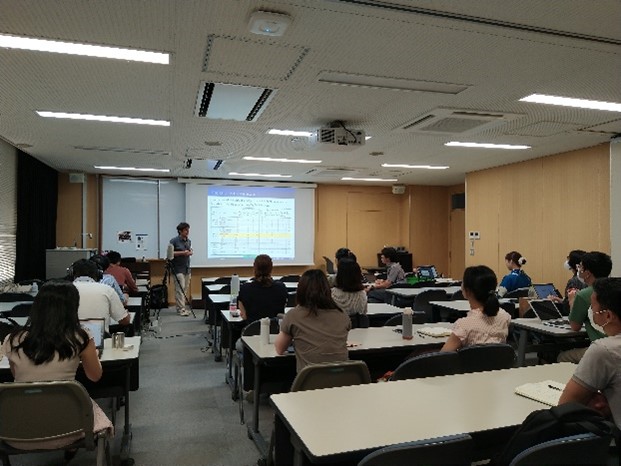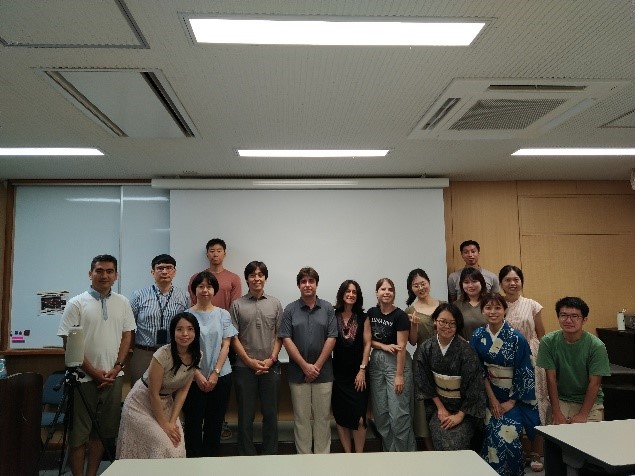Report: Kyoto University School of Public Health International Lecture: Development of a Measurement Scale on Healthy Aging: the ATHLOS Scale
Report: Kyoto University School of Public Health International Lecture: Development of a Measurement Scale on Healthy Aging: the ATHLOS Scale
In the afternoon of July 28, 2023, an international lecture on “Development of a Measurement Scale on Healthy Aging: the ATHLOS Scale” was held at the School of Public Health, Graduate School of Medicine, Kyoto University (KUSPH). About thirty students and faculty members from KUSPH participated in this international lecture, which was held in a hybrid format, on-site and via ZOOM. Prof. Albert Sanchez- Niubo of the University of Barcelona was invited as a guest speaker. The purpose of this international lecture was to introduce the procedures and details of the development of a measurement scale on healthy aging.
First, Prof. Sanchez-Niubo briefly introduced the history of academic studies related to healthy aging, and many researchers and organizations tackled the issue of developing scales to measure various concepts related to healthy aging. According to WHO’s definition of healthy aging, the focus is on function-based approaches, such as intrinsic capacity and physical and social environments. In an effort to measuring healthy aging, one of the important aspects was to universally validate the measurements which can be used in any population, as a universal tool. In response to the need to develop such scale, ATHLOS project started, with the funds from European Union’s Horizon 2020. The initiatives were conducted formally in 2015 and 2020. The task was to create a harmonized measure of healthy aging. In this initiative, sixteen studies from thirty-eight countries were included, and forty-one items were selected for harmonization.
To construct this scale, two parameter logistic item response theory (IRT) model was used. As harmonization proceeded, there were some concerns that some of the items were not good. IRT is a type of latent variable model that link dichotomous variables to a continuous latent variable, which is a healthy aging score. Confirmatory factor analysis was conducted to explain the unidimensionality of the latent trait score. The scale is distributed as a Normal of mean zero and standard deviation (SE) one and was rescaled to a mean of fifty and SE of 10, indicating higher score better healthy aging. IRT also estimates two parameters independent of individuals that indicate for each item, how much it discriminates and its difficulty in being self-reported. For example, some of the variables, such as old people’s difficulties in memory and stopping (physical function), it is more difficult for self-report than easier-to-answer variables such as eating difficulties. Then, an approach was conducted to detect differential item functioning (DIF) across studies. If no DIF, meaning the behavior is similar across all the studies, then the model zero is true. Once which item is good to be used, the Stocking-Lord equating approach was used to use the non-DIF items as anchor items. After deriving multiplicative and additive terms, these two were added.
Finally, the estimation of the parameters were tabulated, in terms of IRT parameter estimates and standard errors.
At the end, the properties of the ATHLOS scale are; successful coverage with an excellent fit, good reliability, and high interclass correlation coefficient between the main scale and each study specific subset of the items. All studies had less than 8 items with DIF, and there were three studies which had no DIF.
Limitations of this study is that the scale depends on selection of items and the quality of harmonization process. Despite the limitations, the methodological approach worked well and had good properties. As future directions, updating the database by harmonizing new waves of studies need to be done. Also, adding new and suitable cohort studies are also desirable.
At the end of the lecture, participants asked questions about the specific characteristics of ATHLOS scale, and possibilities of comparing variables across different studies. Other student asked questions of why choosing IRT to develop scale instead of factor analysis or CFA, and about whether it should be the way that the functionality must be decomposed to intrinsic capacity and environmental factors.
In the conclusion of this lecture, Prof. Kondo mentioned that tremendous efforts are put into harmonize the scale, creating general rules. This methodology is useful to understand the variability across the world, and homogeneity and heterogeneity of data across different studies.

